Range Rover Evoque: Rear Lamp Mounting Panel
Removal
NOTES:
The rear lamp mounting panel is manufactured from mild steel.
The section of the rear lamp mounting panel described within this procedure is for the access for installation of the inner back panel assembly.
The upper NVH component must be replaced when a complete panel is installed.
1. The rear lamp mounting panel is replaced in conjunction with:
- Rear bumper cover
- Rear bumper
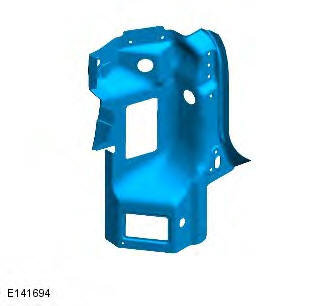
2. For additional information relating to this repair procedure please see the following: For additional information, refer to: Health and Safety Precautions (100-00 General Information, Description and Operation) / Body Repairs (501-25A Body Repairs - General Information, Description and Operation) / Corrosion Protection (501-25B Body Repairs - Corrosion Protection, Description and Operation) / Body and Frame (501-26 Body Repairs - Vehicle Specific Information and Tolerance Checks, Description and Operation) / Standard Workshop Practices (100-00 General Information, Description and Operation).
3. Remove the rear bumper.
For additional information, refer to: Rear Bumper (501-19 Bumpers, Removal and Installation).
4. NOTE: The towing bracket only needs to be removed for the RH rear lamp mounting panel. Remove the rear towing bracket.
5. Remove the liftgate bump stop supports.
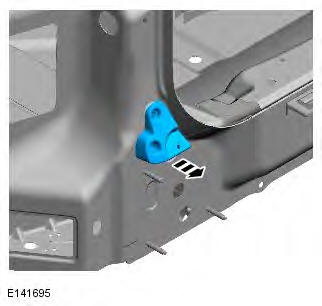
6. Remove the liftgate aperture weatherseal.
7. Remove the load space inner trim.
For additional information, refer to: Loadspace Trim Panel (501-05 Interior Trim and Ornamentation, Removal and Installation).
8. LH only. Release and lay aside the fuse box/relay mounting bracket.
9. Remove the forced air extraction grille.
10. Remove the bumper cover upper guide.
11. Release and lay aside the insulating material.
12. Release and lay aside the wiring harnesses.
13. NOTES:
If the rear lamp mounting panel is being installed complete then move on to the next step.
The section of the rear lamp mounting panel described within this procedure is for the access for installation of the inner back panel assembly. Mark out the position where the rear lamp mounting panel section MIG butt joints are to be made. Cut through the rear lamp mounting panel as indicated.
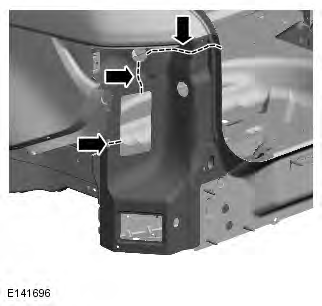
14. NOTES:
If a section of the rear lamp mounting panel is required drill out spot welds where necessary.
Use a belt sander to sand down the spot welds in the areas where access is limited. Drill out spot welds.
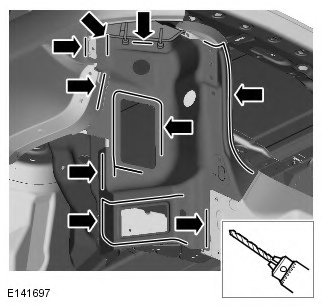
15. NOTE: The upper NVH component must be replaced when a complete panel is installed. Separate and remove the upper NVH component as indicated.
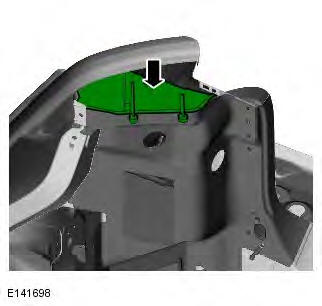
16. NOTE: If the NVH component is damaged on separation, a new component will be required. Separate the joints and remove the old panel, also releasing the lower NVH component from the old panel as indicated.
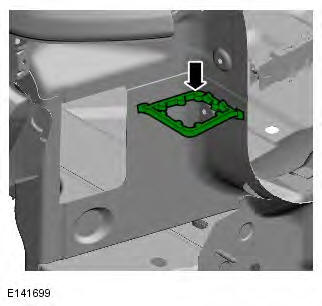
Installation
1. NOTE: Mark and cut the butt joints in relation to the removal of the rear lamp mounting panel section. If a section is required mark out the position on the rear lamp mounting service panel, where the section MIG butt joints are to be made and cut the panel at the points indicated.
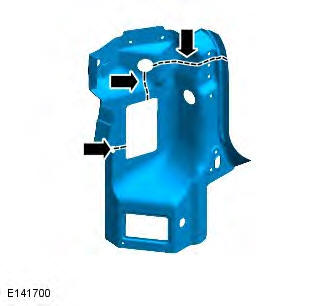
2. Prepare the old and new panel joint surfaces, including NVH components.
3. NOTE: With panel in position check for access to spot weld the joints. Offer up the new panel and clamp into position. Check alignment, if correct, proceed to next step, if not, rectify and recheck before proceeding.
4. NOTE: Using the removed spot weld hole as a template drill MIG plug location through new panel taking care not to drill into the water drain panel. While the new panel is clamped in position drill out MIG plug location as indicated.
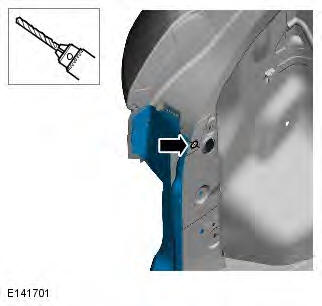
5. Remove the new panel.
6. Drill holes in new panel ready for MIG plug welding where there is no access to spot weld.
7. Deburr MIG plug locations in new panel.
8. NOTE: if spot welds are being installed in a joint that originally contained adhesive, the adhesive must be reinstated. Apply panel bonding adhesive to spot welded/bonded areas as indicated. Use the bond path shown in the graphic as a guide, the panel bond adhesive must only be applied in the areas where spot welding is accessible for the installation of the new panel. It is not to be applied in any areas of MIG welding/brazing installation joints, leave a 30mm gap, so it does not affect the MIG weld/braze joint on installation.
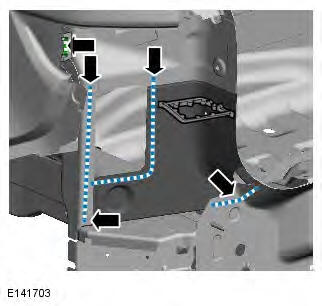
9. Apply sealer adhesive to the lower NVH component as indicated.
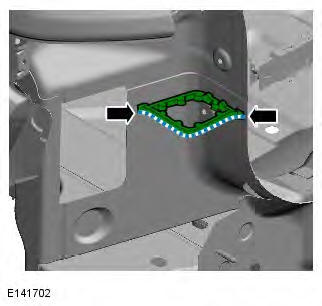
10. Offer up the new panel and clamp into position. Check alignment, if correct, proceed to next step, if not, rectify and recheck before proceeding.
11. Spot weld where access is available.
12. MIG plug weld where there is no access to spot weld.
13. Dress the MIG plug welds.
14. Apply etch primer to any bare metal surfaces at this stage in the upper NVH area.
15. Apply sealer adhesive to the upper NVH location on the vehicle.
16. NOTE: The upper NVH component flap must be shut until it is installed. Once installed the flap must be opened. Install new upper NVH component.
17. When the upper NVH component is installed it must be completely sealed with sealer adhesive.
18. Apply a zinc rich primer to any bare metal surfaces at this stage.
19. NOTE: Make sure all body joints are sealed following this repair procedure
The installation of associated panels and mechanical components is the reverse of removal.

